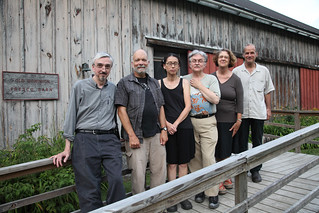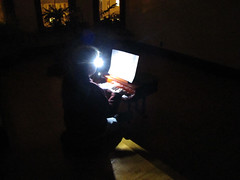Sat Apr 07, 2012
There were three sources of
preexisting material in
the performances of Low Concept: Brecht/Weill's song
Die Seeräuber-Jenny ("Pirate Jenny"), the Adagio from Ravel's G major piano concerto, and Laurie Anderson's music
O Superman music video. The first was evident, as I exposed the song in four stages, concluding with a kind of performance/staging in German. The second remained unnamed: I performed the first part of the Adagio, transcribed for a single piano, on a toy piano. If someone knew the music well enough they might have recognized it, though I don't believe anyone did. The third remained quite buried. I quoted only a brief passage from Anderson's lyrics, and only once. What I did quote and enact, at several points, was a description of the gestures she uses in her original music video (viewable
here for example). Interesting intellectual property question, possibly: the video work is hers, her performance is hers, but the text below is "mine," I believe.
I did not attempt to describe one passage ("neither snow nor rain" etc.) where she makes use of sign language. I didn't want to hack around with a language I do not understand - like imitating the sounds of a spoken language you don't understand. You could just wind up mocking people.
The full rendition of Pirate Jenny segued directly into the italicized portion of the text below, which the audience had seen three times before, but now for the first time with the words: 'Cause when love is gone/there's always justice/and when justice is gone/there's always force/and when force is gone/there's always Mom/Hi Mom. That may have been the moment when people suddenly realized why Laurie Anderson was credited on the program. (Thank you Laurie Anderson. I still love this work.)
O Superman gesture score
Left arm raised, elbow at chest height and bent, fist closed at shoulder height
lowered almost horizontally, raised again, lowered, raised again
hand open, fingers together, thumb separate – elbow straightened and bent in a stiff handwaving gesture
arm dropped to side
arms at sides, elbows at sides, forearms slightly extended – straighten elbows so arms angled away from body
raise forearms and elbows away from sides – elbows bent at chest height, forearms up making V, hands open
then curl hands in to body above shoulder height
open hands flat again, make “money” gesture with fingers
rotate hands so backs of hands are toward body, forefingers point horizontally away from body
open hands flat so palms face front
left arm, elbow at side, palm open to front, 3rd-5th fingers curled slightly in front of index finger
gun gesture with thumb and index finger, 3rd-5th fingers curled in to palm
palm opens, facing up – forearm still at same angle to body and elbow at side
turn palm to face front, move palm toward viewer
r
ight arm crossed in front of body, hand open, fingers together, placed above heart
open arm extended to right, elbow close to but not at body, slightly bent – forearm horizontal
turn palm up, raise left arm and hand in same position –look at left hand – tilt arms back and forth
turn arms over, palms down but curled out as if pushing away, then lower arms at sides and look down
raise arms away from body, elbows bent at chest height, fists at eye level
then drop arms – inverted, forearms hang vertically from bent elbow in same position, fists hanging at end of forearms
then repeat raising and dropping fists
raise arms to same height, elbows bent at same height, open palms pointing up making 90 degree angle with head
then move hands to face front
relax hands
lower left arm to horizontal position, hand open but facing down, wave hello with right arm in same position
Left arm raised, elbow at chest height and bent, fist closed at shoulder height
straighten elbow and extend arm, palm facing front, fingers together, thumb separate
bend elbow so upper arm is at 90 degree angle, separate all fingers and thumb, palm still forward
straighten elbow and turn hand into gun gesture
bend elbow and raise hand with gun gesture – when index finger is pointing up, curl hand into fist
straighten elbow with fist – when arm horizontal, point sideways with index finger
bend elbow with index finger extended – when index finger pointing up, curl hand to make a bird head silhouette
extend bird head slightly – open “beak” three times
raise hand to face front, open fingers, forearm toward body, elbow in same position
straighten elbow and extend hand with pointing forefinger
bend elbow and turn forefinger so pointing at self
turn hand and make “rabbit” with thumb and forefinger curled and touching, three fingers curled above
quickly extend forefinger pointing to left
bend elbow, open hand facing front, open fingers – bend elbow further so open hand angles towards body, then
straighten elbow so hand faces out
bend elbow again
straighten elbow so index and middle fingers extended, together, point left, thumb atop index finger, other fingers curled in
bend elbow so index and middle fingers point up
straighten elbow, then bend it again, all fingers together, palm slightly curling so fingertips point toward body
straighten elbow, palm facing up, pull left sleeve with right arm
bend elbow to make fist – facing toward body
straighten elbow – index finger pointing left
bend elbow – fist turns toward body, index finger curls over fist
mostly straighten elbow – relaxed finger extends at a gentle angle upward and out
immediately bend elbow, open fingers, palm facing front
straight elbow, palm forward – repeatedly bend and flex elbow with open fingers facing forward, increasing pace
end in fist with elbow bent
Notated by David Miller, March 2012

